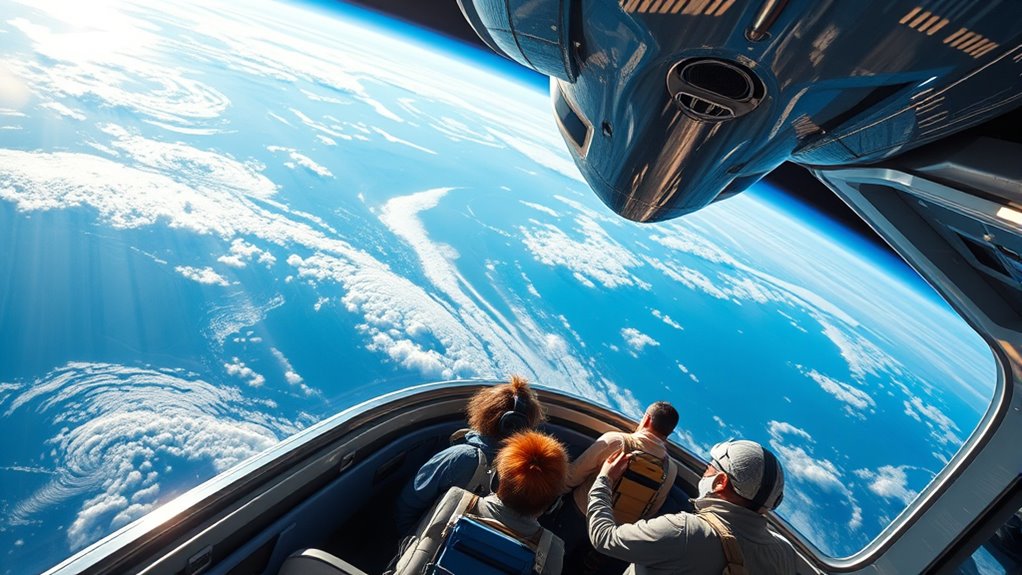By 2026, space tourism has become more accessible and mainstream, with technological breakthroughs like reusable rockets reducing costs and increasing flight frequency. Companies are expanding infrastructure, including private space stations and orbital hotels, while balloon-based trips grow in popularity for shorter journeys. Safety remains a priority, but environmental concerns and regulations still shape development. If you keep exploring, you’ll discover how this exciting industry continues to evolve and open new frontiers for everyone.
Key Takeaways
- Space tourism has transitioned from a luxury niche to a growing industry, with more accessible suborbital and orbital options.
- Reusable rockets like SpaceX’s Starship are enabling more frequent, cost-effective space flights.
- Infrastructure development, including private space stations, is progressing but faces regulatory and safety hurdles.
- Industry efforts focus on sustainability, greener propulsion, and reducing environmental impact amid increased launches.
- Expanded market offerings include balloon tourism and emerging concepts like orbital hotels and zero-gravity entertainment.

By 2026, space tourism is rapidly transforming from a niche luxury into a burgeoning industry driven by technological breakthroughs and growing public interest. As more companies push toward making space travel more accessible, the development of launch infrastructure plays a pivotal role. Reusable rockets like SpaceX’s Starship are nearing operational status, enabling more frequent flights and lowering costs. This expanded launch infrastructure supports a broader range of missions, from suborbital hops to multi-day orbital stays, fueling the industry’s growth. However, with increased launch activity comes environmental concerns. The rise in rocket launches raises questions about the environmental impact, especially regarding emissions and space debris. Industry leaders are investing in greener propulsion systems and sustainable practices to minimize these effects, but the challenge remains significant. Balancing rapid expansion with environmental responsibility is critical; delays and regulatory hurdles often stem from safety and ecological considerations. Agencies like the FAA and NASA emphasize rigorous testing and oversight to ensure safety, but this regulatory landscape can slow down development, affecting the pace of infrastructure deployment. As companies work to establish private space stations and orbital hubs, the environmental footprint of these facilities also comes under scrutiny. These stations will serve as tourist hubs, but their creation and operation must align with sustainability goals to avoid exacerbating space pollution or harming Earth’s atmosphere. The environmental impact of space tourism is increasingly scrutinized, prompting calls for sustainable practices across the industry. Meanwhile, technological advancements are making space tourism more feasible and less costly. Reusable rockets and breakthroughs in propulsion technology are drastically reducing the cost per seat, with suborbital prices expected to fall from around $450,000 to near $200,000–$300,000 by 2030. Balloon-based tourism, which offers shorter, more affordable trips, is growing at an impressive pace, appealing to a broader demographic despite still targeting the affluent. These innovations are expanding the market, but safety remains a top priority. Companies like Virgin Galactic have paused operations to refine their vehicles, emphasizing safety over speed. Regulatory frameworks are evolving, but uncertainty persists, influencing market stability and growth projections. The industry continues to evolve beyond just wealthy elites, with emerging concepts like orbital hotels and zero-gravity entertainment still in early stages. While orbital tourism remains limited to ultra-wealthy individuals—mainly through missions to the ISS—future developments aim to democratize access. As the industry advances, the growth of launch infrastructure and a focus on environmental impact will determine whether space tourism can sustain its rapid expansion. Investments and innovations are paving the way, but responsible growth will be key to ensuring this industry’s long-term success.
Frequently Asked Questions
What Are the Safety Records of Current Space Tourism Companies?
You should know that space tourism companies have mixed safety records. Virgin Galactic experienced one death during a test flight, but no in-flight fatalities among paying passengers. SpaceX boasts no passenger deaths but faces workplace injury concerns, and Blue Origin maintains a clean safety record. While spacecraft safety and emergency protocols are improving, industry oversight remains inconsistent, and workplace hazards persist—highlighting the need for stricter regulation and transparent safety standards.
How Affordable Are Space Tourism Experiences for Average Consumers?
Space tourism remains largely unaffordable for the average consumer due to high costs. With suborbital flights costing over $200,000 and orbital experiences exceeding $50 million, ticket affordability is limited to the wealthy. While cost reduction efforts and technological advances aim to lower prices, significant affordability for most people isn’t expected until well into the next decade. Until then, space tourism stays a luxury reserved for high-net-worth individuals.
What Are the Environmental Impacts of Increased Space Tourism Activity?
As you watch rockets streak across the sky, remember they contribute to space debris and atmospheric pollution. Increased space tourism can boost emissions, release soot, and generate metal nanoparticles that deplete ozone and warm the atmosphere. These tiny fragments, like falling stars, linger in the stratosphere, disrupting climate and ozone recovery. Your desire to explore space carries environmental costs, urging us to adopt cleaner, sustainable practices to protect our planet’s fragile atmosphere.
How Do Space Tourists Prepare Physically and Mentally for Trips?
You prepare for space trips through physical conditioning and mental resilience training. You’ll undergo medical evaluations to verify fitness, focusing on cardiovascular, respiratory, and musculoskeletal health. Resistance exercises strengthen your bones and muscles, while centrifuge sessions help you tolerate G-forces. Mentally, you’ll build resilience with stress management strategies, simulations, and safety briefings, helping you stay calm during emergencies. This thorough prep ensures you’re physically and mentally ready for the unique challenges of space travel.
What Future Technological Advancements Could Make Space Tourism More Accessible?
Future technological advancements, like spacecraft innovations and virtual reality, will make space tourism more accessible. You’ll experience fully autonomous, reusable spacecraft that lower costs and improve safety. Virtual reality can prepare you for the trip by simulating space environments, reducing anxiety and boosting confidence. These innovations will streamline the journey, expand destinations, and offer immersive pre-flight experiences, making space travel easier and more inviting for everyone, not just the wealthy.
Conclusion
So here you are, dreaming of space trips in 2026, while actually booking your seat might still be a distant dream. Ironically, we’ve made giant leaps—yet, a ticket to the stars remains a luxury few can afford. You might think we’re all set, but in reality, we’re still orbiting the idea of space tourism. Who knew that reaching for the stars would take a little longer than just clicking “buy now”?








